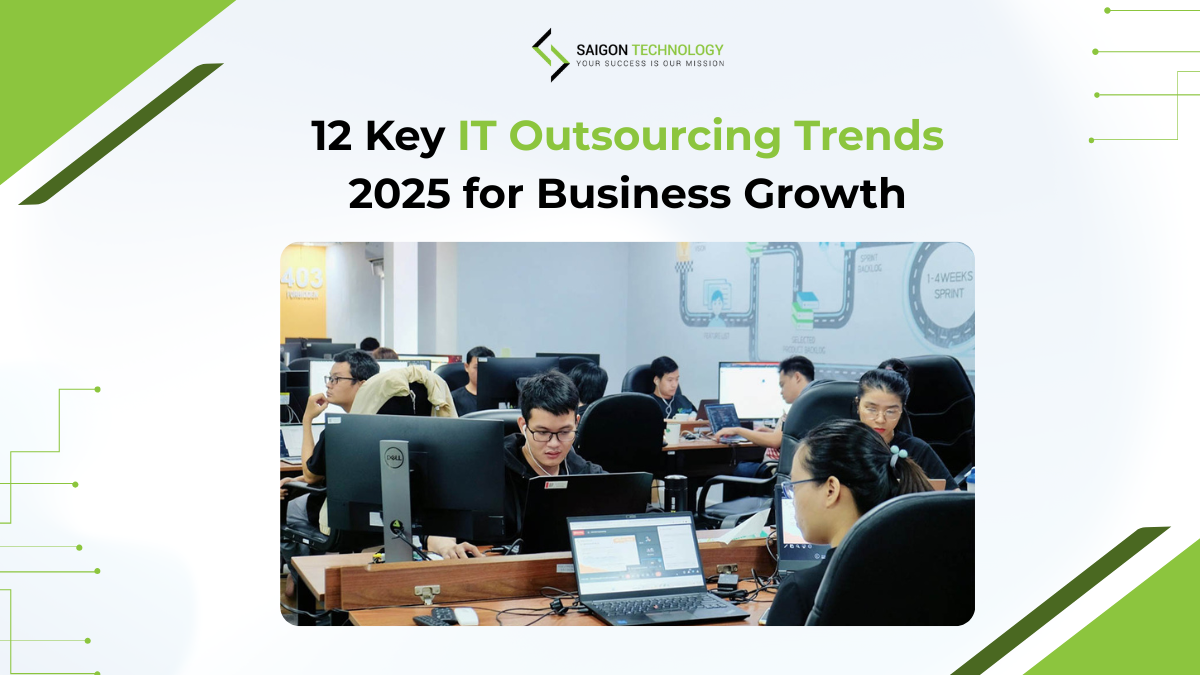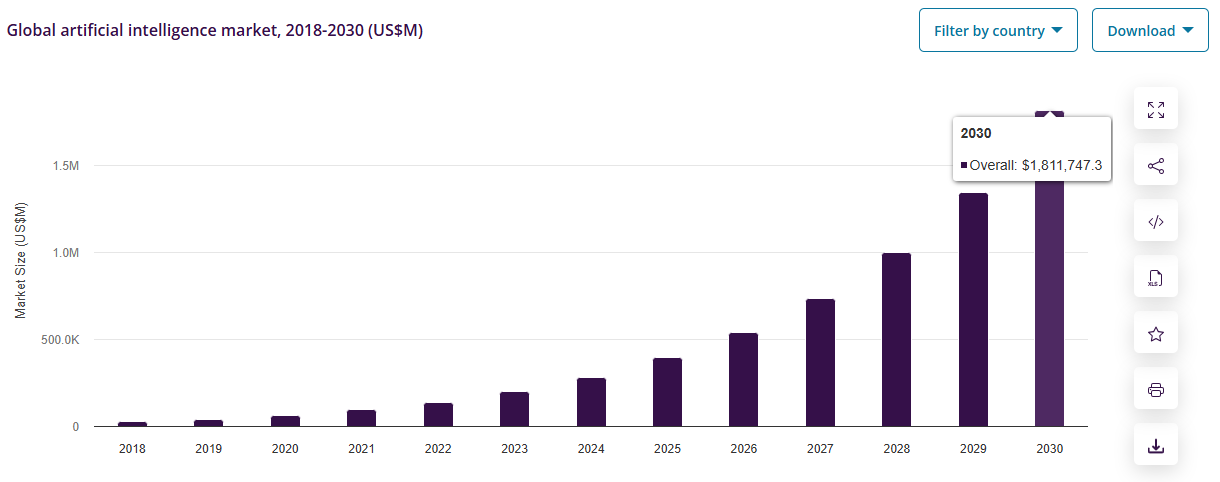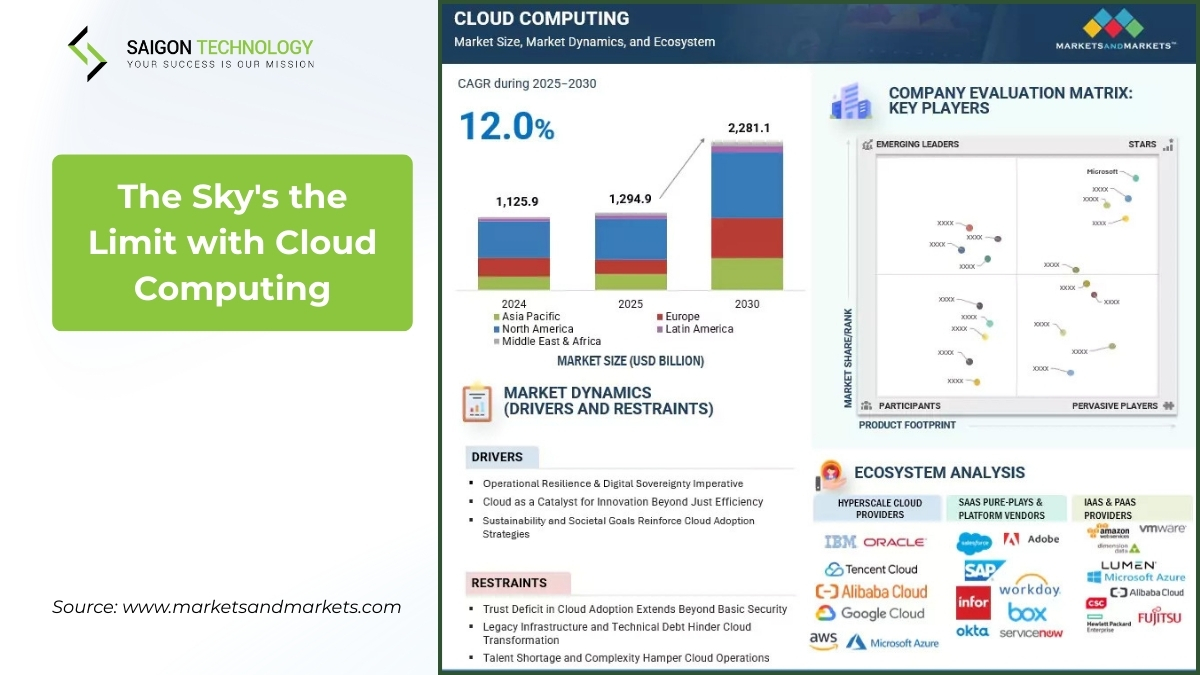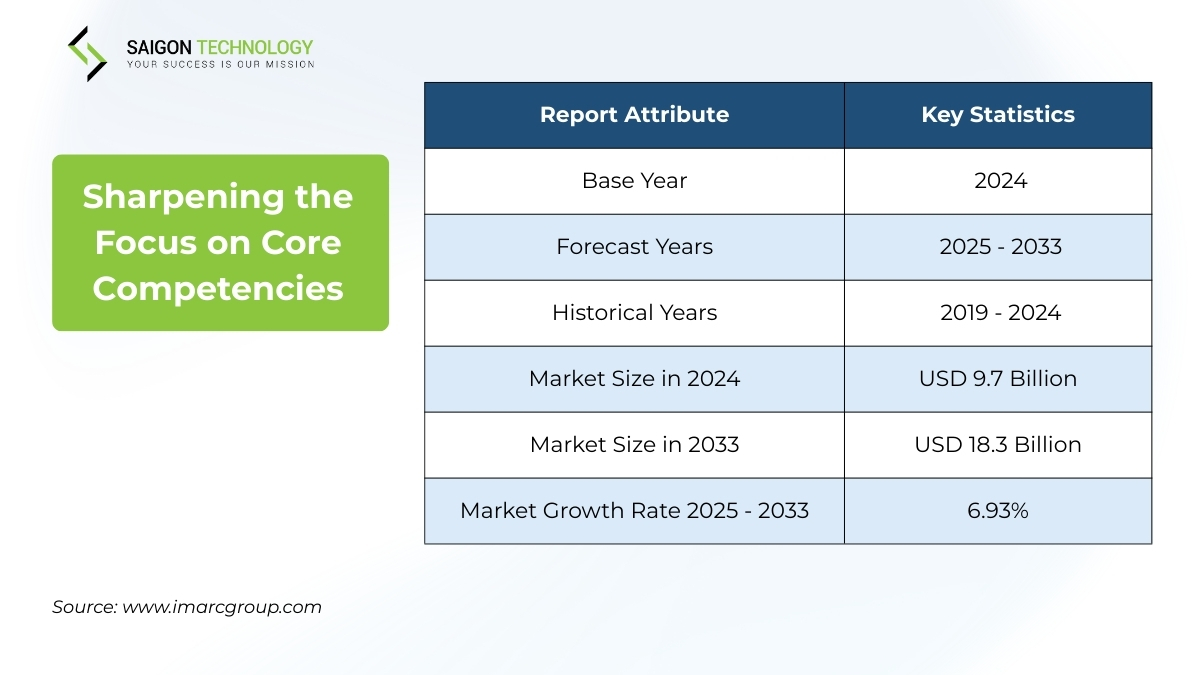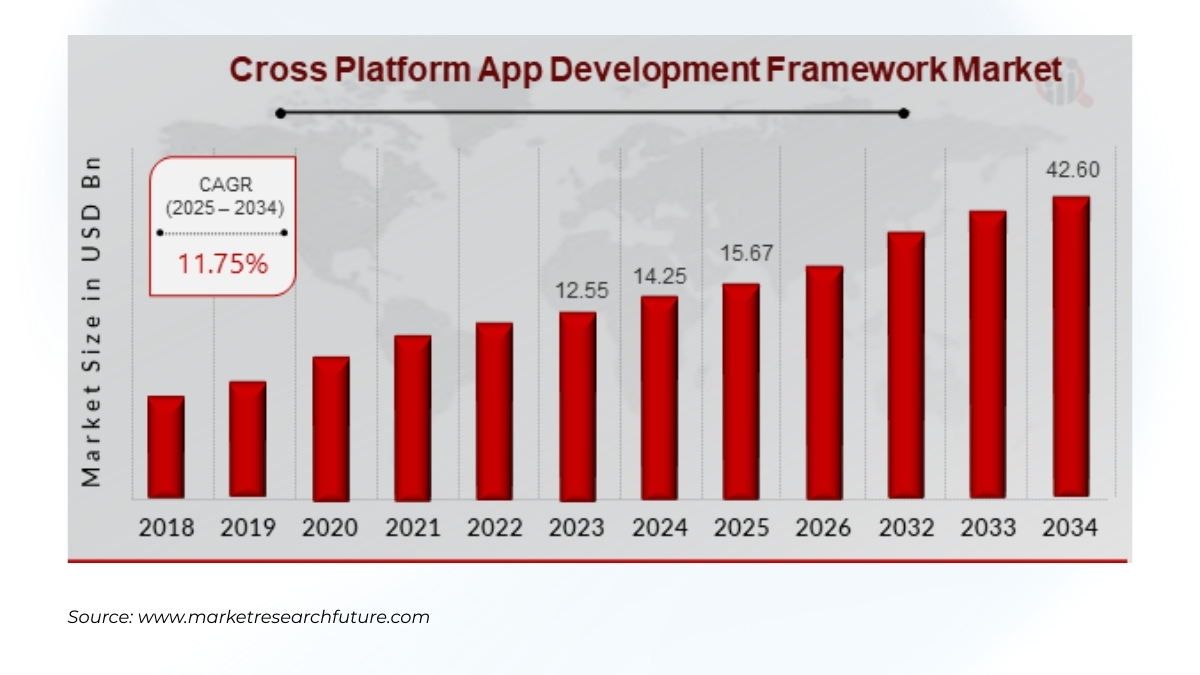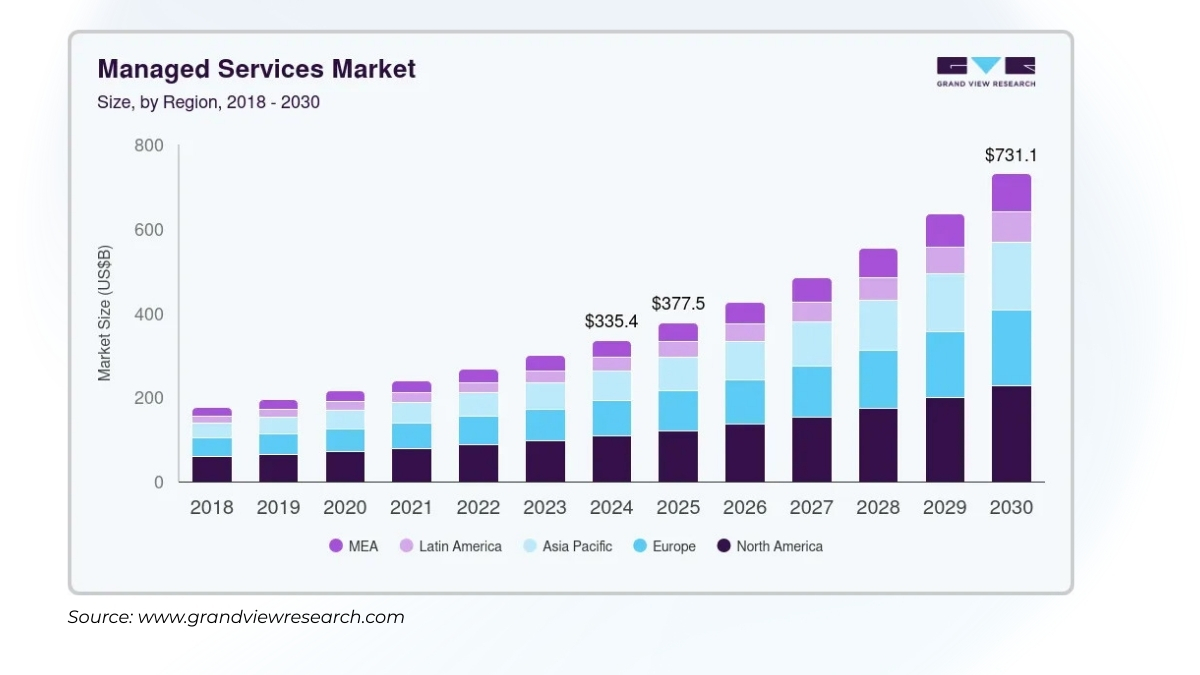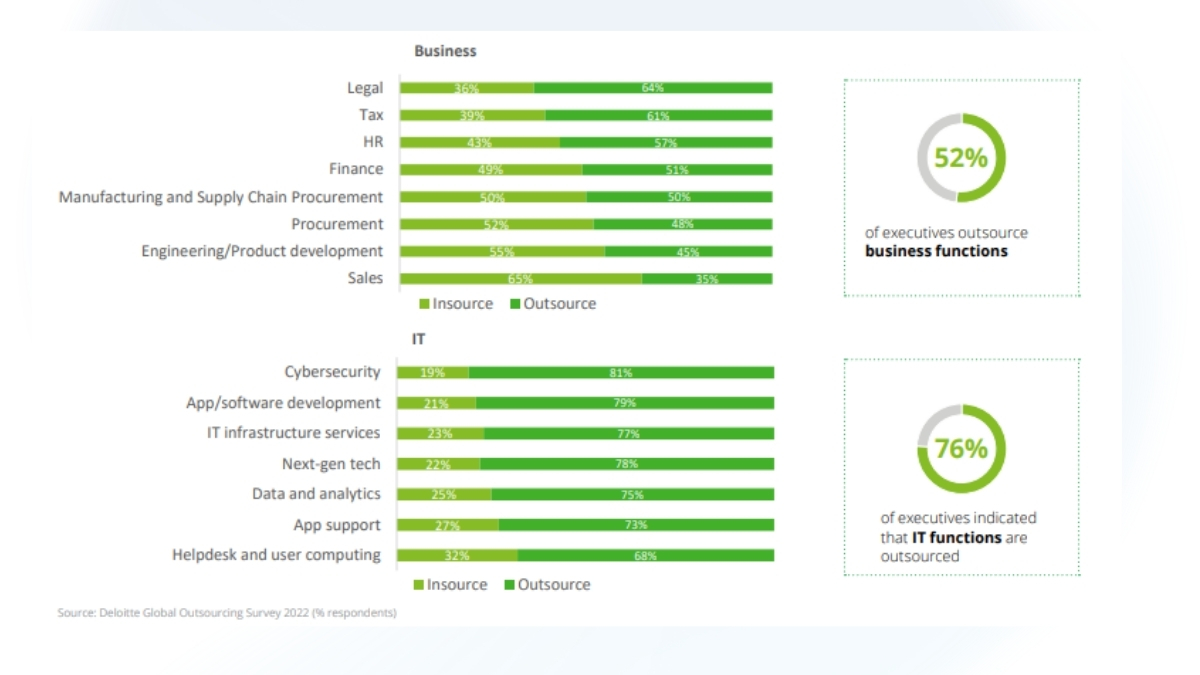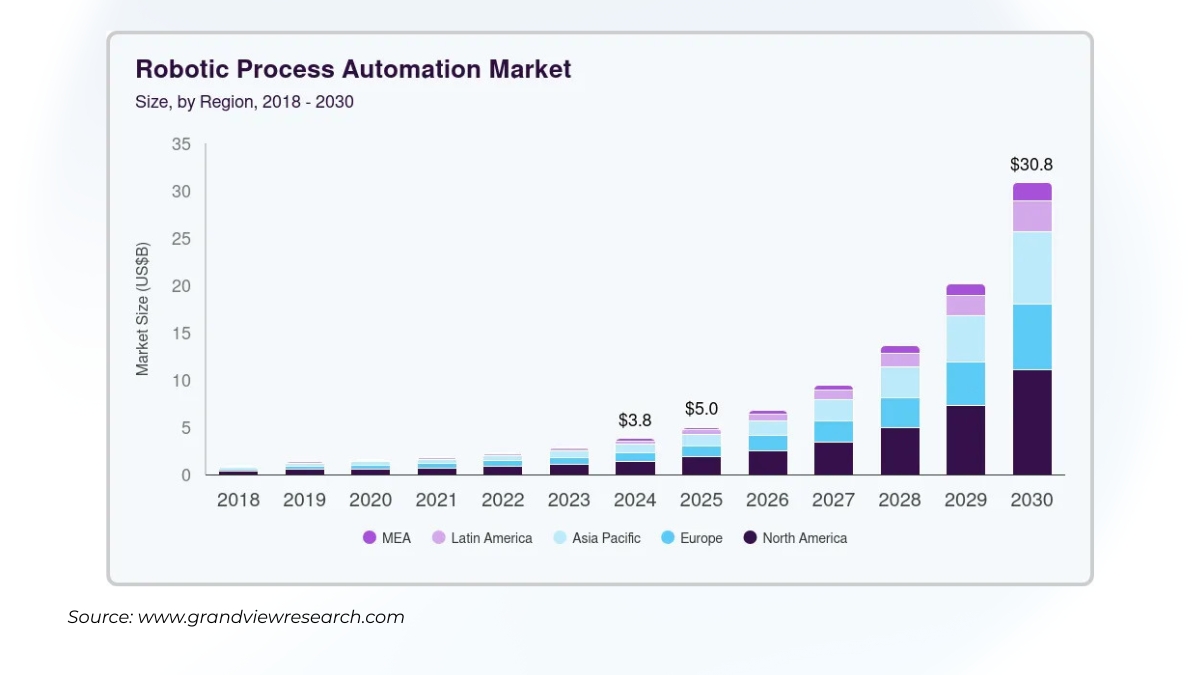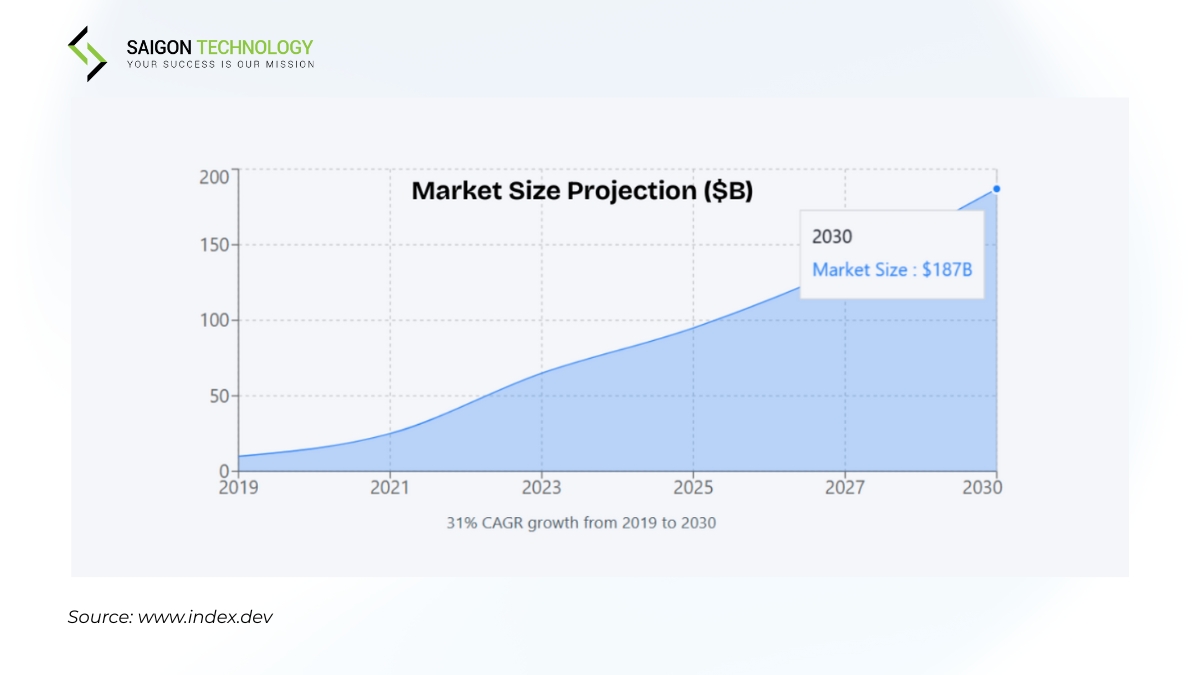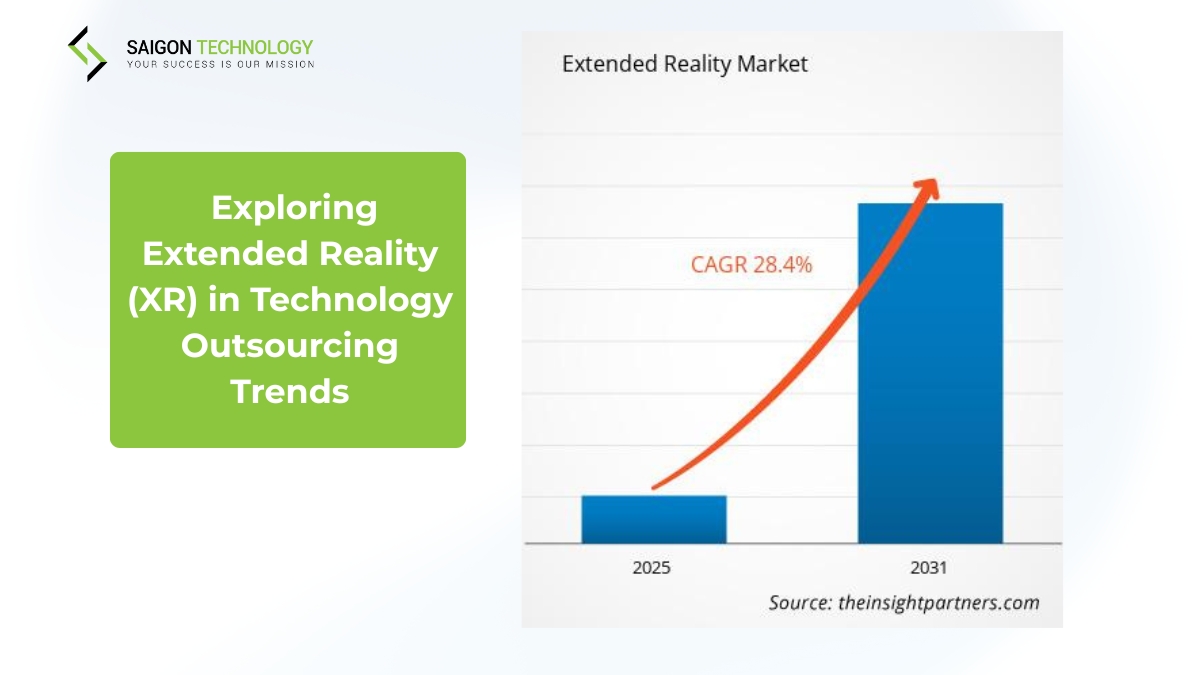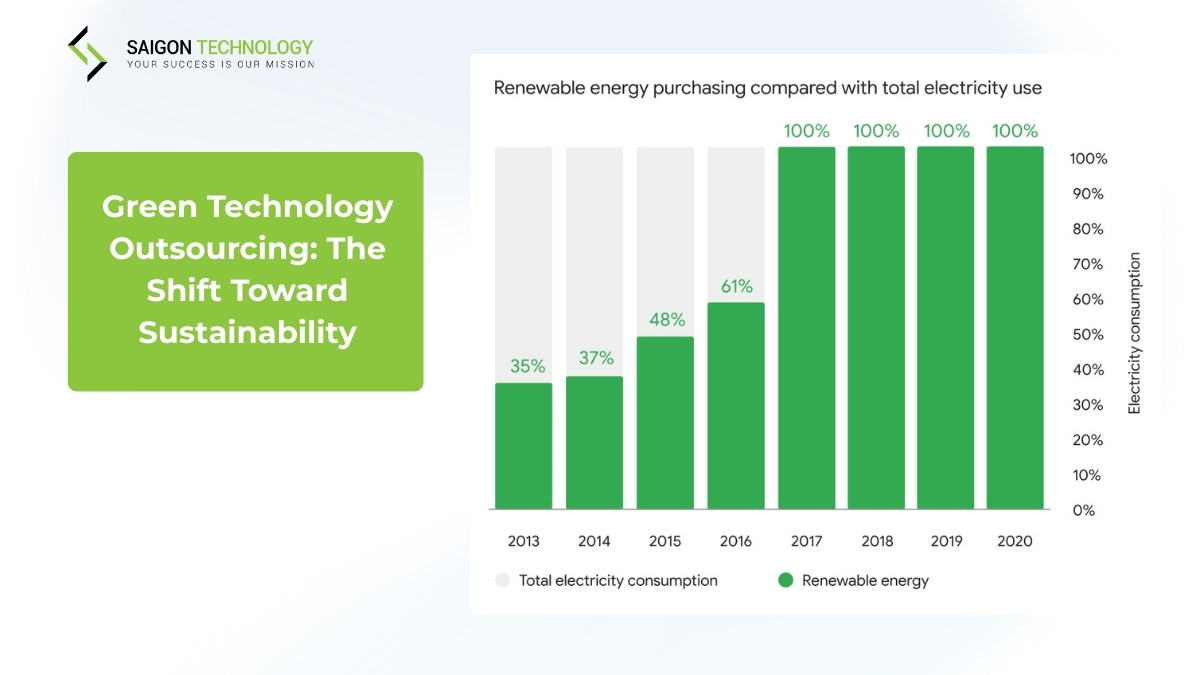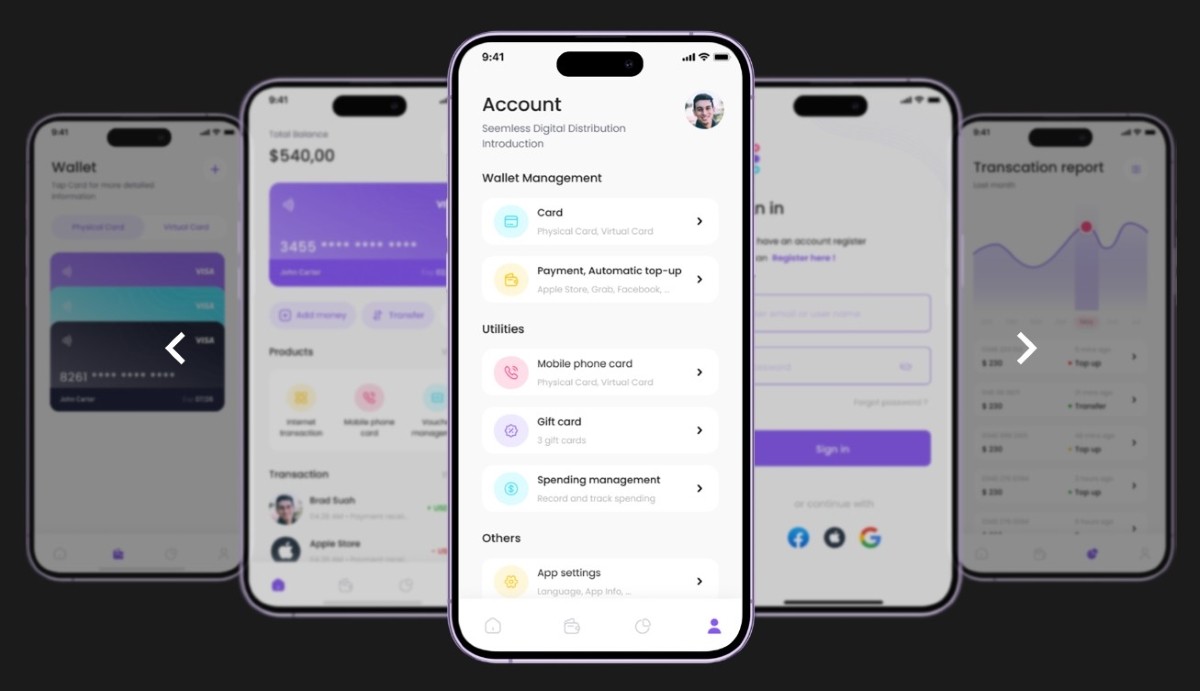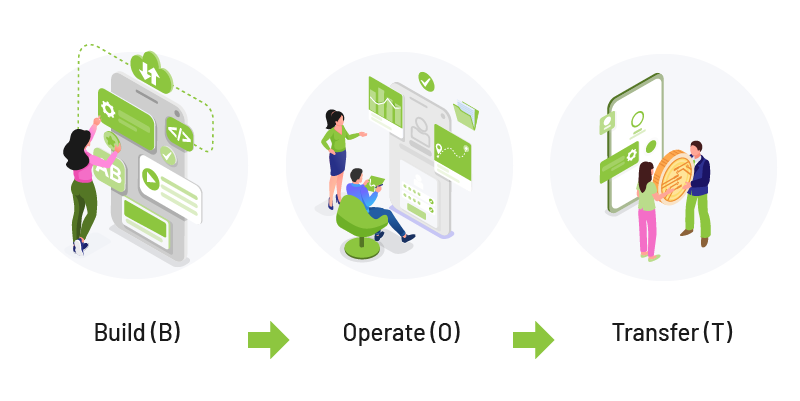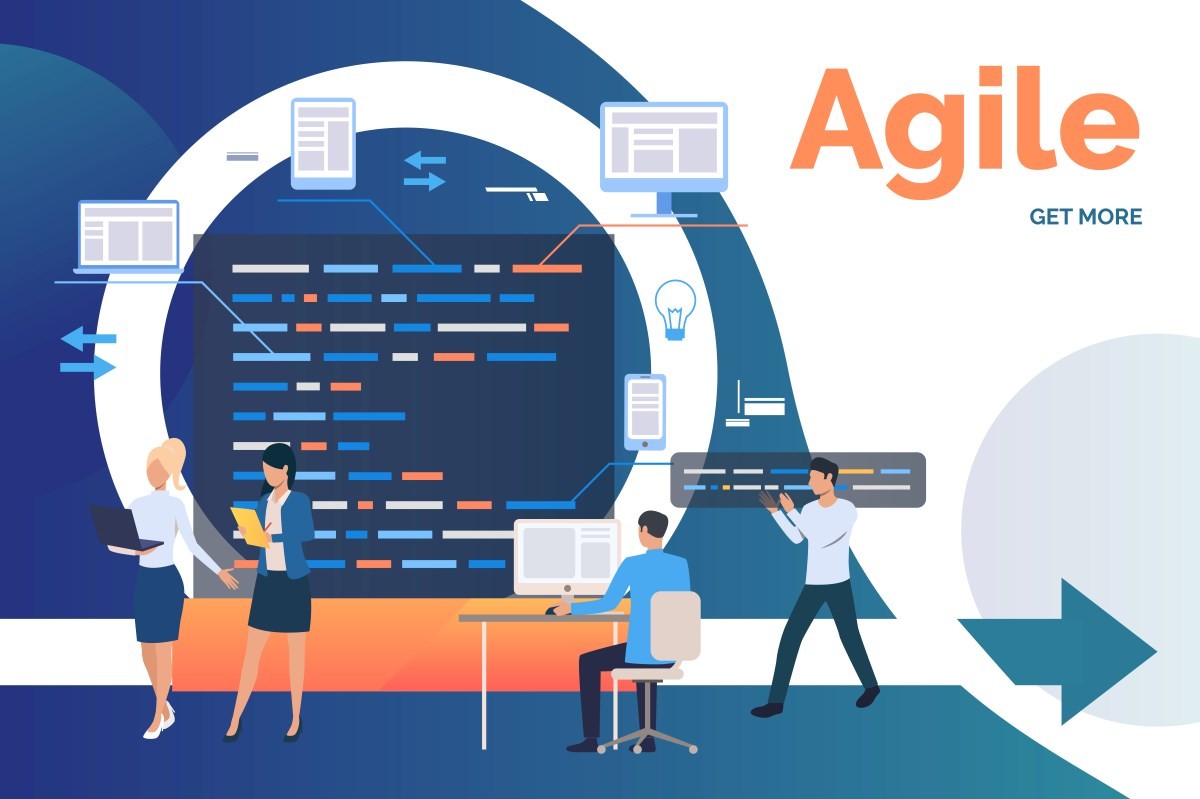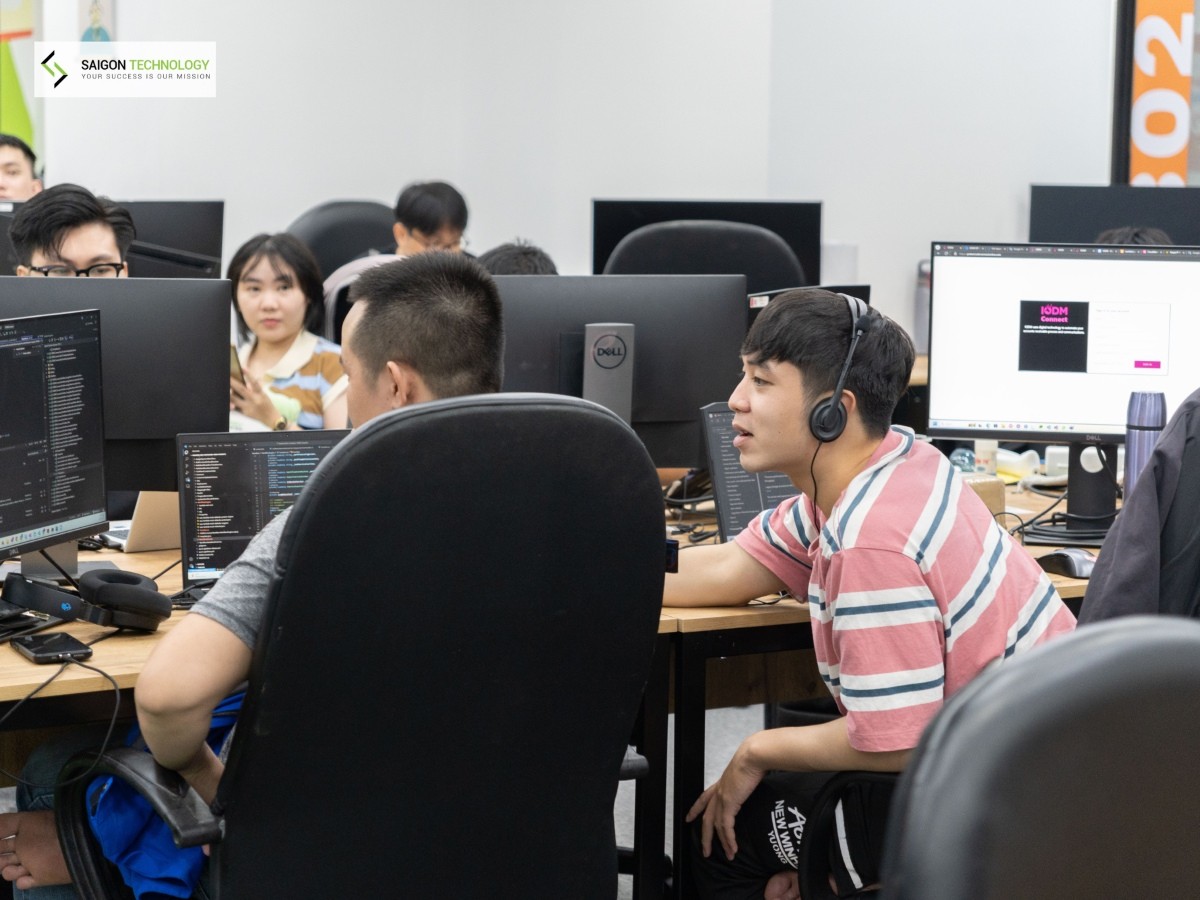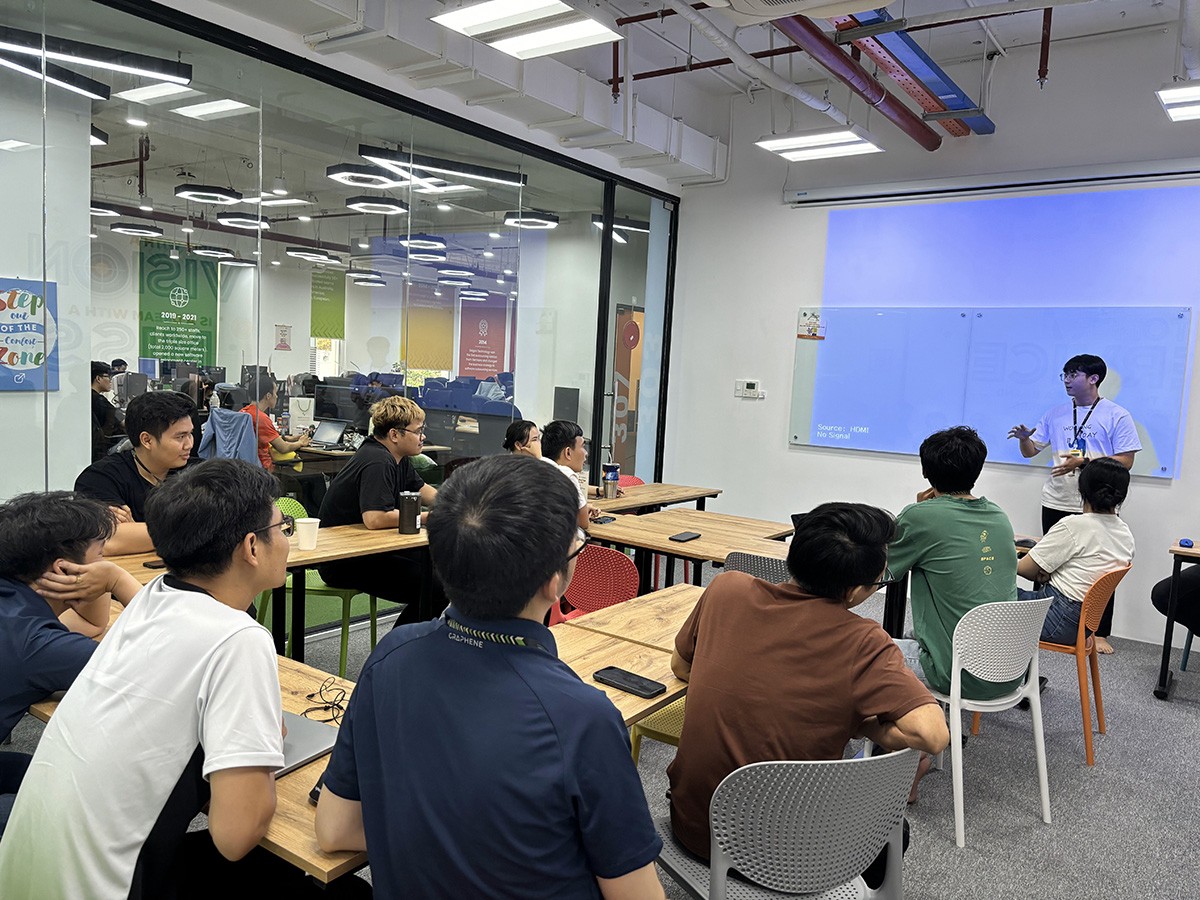IT outsourcing trends are about much more than just saving money. Businesses have to deal with inflation and labor shortages. Outsourcing tasks helps them scale quickly and speed up product development. So, what software development outsourcing trends should you follow in 2025? You really need a smart IT strategy to stand out. Check out 12 key trends right here to give your business an edge!
What Does the Market Forecast Say about IT Outsourcing?
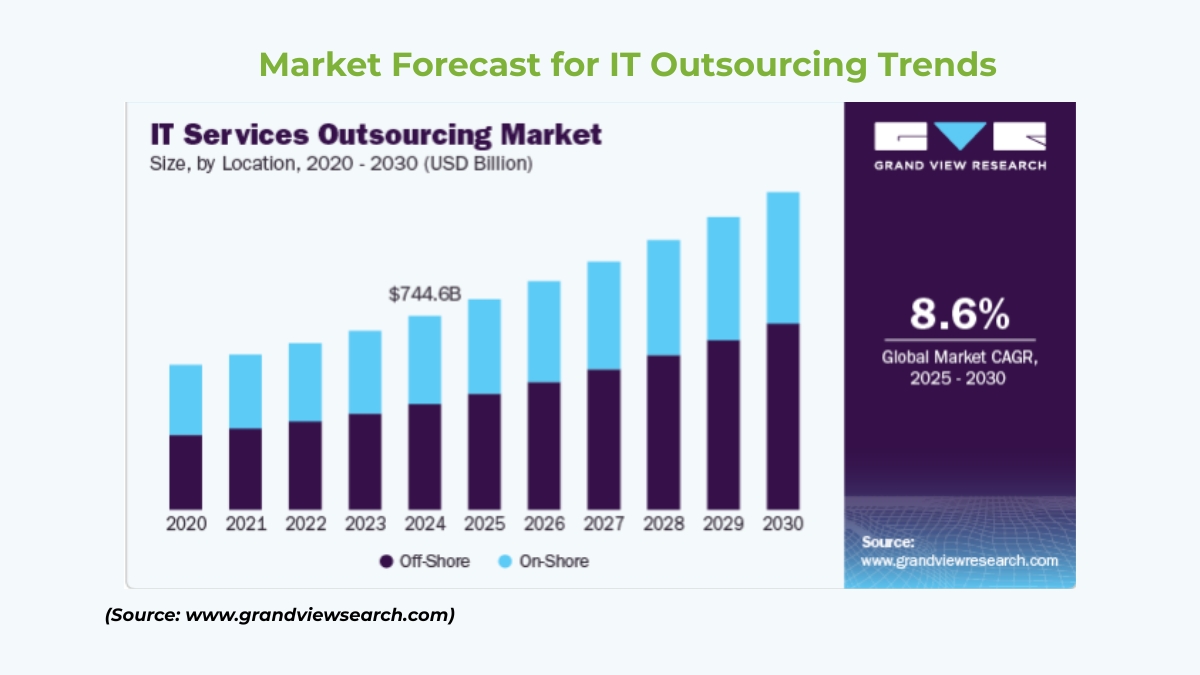
Want to keep up with IT outsourcing trends? Let’s look at where the IT outsourcing market is headed!
- Strong Market Growth: 57% of recruitment managers think finding skilled IT staff is difficult. The demand for technology outsourcing trends leads to a bigger market size. Its market value was $744,623.5 million in 2024, with a CAGR of 8.6% from 2025 to 2030.
- Enterprise Adoption: About 92% of Global 2000 (G2000) companies use outsourced IT services, reflecting the popularity of the IT outsourcing industry.
- Average Cost Savings Achieved: Outsourcing can cut costs by 15 to 30%. The cost advantages help tighten IT budgets and provide access to expert skills without full-time hire.
- Emerging Trends: Outsourcing growth attracts many businesses worldwide. More than 70% of US tech companies have outsourced to Latin America.
How Will the IT Outsourcing Market Transform by 2025?
1. From Cost-Centric to Value-Driven Engagements:
- Cost saving is not the only goal of outsourcing strategies. Businesses now prioritize value-driven outsourcing.
- Project-based model offers flexibility to access needed skills.
- Multiple global delivery models enhance efficiency and speed.
2. Talent Scarcity Driving Global Expansion:
- Offshore software development is rising due to the tech talent shortages in developed markets, driving IT outsourcing trends.
- Southeast Asia is popular for outsourcing, with Vietnam and the Philippines leading.
- Mexico and Latin America offer a time zone advantage to US companies.
- You can address skill gaps through professional outsourcing, dedicated centers, multi-sourcing, and BOT.
3. Regionalization & Nearshoring Over Offshoring:
- Many companies prefer nearshoring because of the similar time zones and languages.
- In Latin America and Eastern Europe, cloud migration and cloud-first strategies are upgrading the outsourcing landscape. India leads in business process outsourcing (BPO).
4. Specialized Niche Providers vs. Generalists:
- One of the benefits of outsourcing IT is that you can access outsourcing firms with domain-specific expertise while following outcome-based delivery models.
- Niche providers prioritize measurable results over working hours to ensure value for clients.
5. AI, Automation & DevOps-Driven Models:
- The future of software development outsourcing shines with advanced technologies.
- AI, big data, and cybersecurity are thriving IT outsourcing trends. Outsourcing firms need to reskill and adapt fast.
A Closer Look at 12 Key IT Outsourcing Trends
1. Harnessing AI and Automation in Software Development
Source: grandviewresearch.com
The AI software development industry is booming. By 2030, global revenue may hit $1.81 trillion. Businesses are turning to AI outsourcing to stay ahead. Why so?
AI and ML, including generative AI, automate software development tasks. AI-enabled workers and AI testing frameworks assist with coding tasks. You can perform AI-powered automation for faster and more reliable outcomes.
AI and ML improve user experience with personalization. You can ensure smarter recommendations and better decision-making..
Please note that AI is still a new technology. Hednce, it may be challenging to find experts. Outsourcing will make it easier, lowering costs for R&D.
Best Practices:
- Work with outsourcing partners that have proven AI and ML expertise.
- Check if they have delivered any similar projects. They should have certified experts and a strong development process.
- Make sure they use the best AI and ML software development practices. You need to focus on data quality, security, and privacy. Testing and documentation are essential here.
2. The Sky’s the Limit with Cloud Computing
The global market of cloud computing is set to increase from $1,125.9 billion in 2024 to $2,281.1 billion by 2030. Hence, consider cloud computing among the top IT outsourcing trends.
Cloud computing enables access to data and apps from anywhere. Cloud-native services help operate smoothly on the cloud. You can choose from public clouds, private clouds, and serverless computing.
Transferring data and apps from traditional infrastructure to the cloud requires careful planning. You need an experienced provider for a smooth transition. With experts handling cloud management, you can focus more on your business growth and cut infrastructure costs.
Best Practices:
- Choose a service provider that has delivered cloud services.
- Prioritize those with different cloud solutions. You can then have more choices.
- Consider a partner that deals well with cloud migration. They can cover assessment and optimization for you.
3. Securing the Future with Cybersecurity
Cybersecurity threats are rising. Businesses face tons of issues, such as data breaches and attacks from hackers. In the US, 76% of states outsourced security operations in 2024. This figure in 2022 was just 52%. Now is the time to strengthen your defenses – consider cybersecurity outsourcing!
Many companies choose security-focused outsourcing services for better data protection and compliance management. We use modern solutions like SIEM, penetration testing, and MDR to protect your business from cyber threats.
Outsourcing cybersecurity has big advantages. Experts handle security using the latest tools and best practices. Moreover, you can get 24/7 threat monitoring. With outsourcing, you can ultimately save time and reduce costs.
Best Practices:
- Partner with firms that continuously follow the latest cybersecurity trends.
- Choose end-to-end services. Your partner then detects, prevents, responds to, and recovers from threats.
4. Sharpening the Focus on Core Competencies
Revenue generation is the first thing to do. Outsourcing helps free up internal teams for high-value work. This increased focus leads to better products and services. As you satisfy your customers, you can experience higher profits.
So, what functions to outsource? You can consider Helpdesk. In this manner, the external team provides customer support, cloud management, and cybersecurity. The global help desk outsourcing market was worth USD 9.7 billion in 2024. This figure may grow to USD 18.3 billion by 2033, with a CAGR of 6.93%.
Many companies follow software outsourcing trends to improve efficiency. Microsoft outsourced its internal IT services to Infosys. Then, Infosys cut costs and managed global support using Microsoft‘s software. Outsourcing also supported hiring freezes as the business didn’t recruit internal staff.
Best Practices:
- Choose a partner who can manage outsourced tasks effectively.
- Select the one with a strong reputation and proven experience.
5. Breaking Boundaries with Platform-Independent App Development
The cross-platform development market is expanding rapidly. It can grow from $15.67 billion in 2025 to $42.60 billion by 2034.
Frameworks like React Native and Flutter are leading this trend. They help developers create apps for multiple platforms. Cross-platform development saves time and effort. You can ensure a consistent user experience.
You can outsource your cross-platform apps. Cross-platform solutions are among the rising IT outsourcing trends. The specialized teams reduce development time and costs. Many industries, like e-commerce, healthcare, and fintech, value the consistent performance of cross-platform apps to increase user engagement.
Best Practices:
- Choose a partner with a deep knowledge of multiple platforms.
- Select a team with certified experts. They should have a strong track record in platform-independent app development.
6. Riding the Wave of Managed Services
You should choose proactive managed IT services. It means you closely monitor and maintain your IT systems. Hence, you can prevent problems before they disrupt your business. The services include 24/7 IT support, cybersecurity, and cloud infrastructure management.
According to Grand View Research, the global managed services market can be worth USD 731.08 billion by 2030. Its annual growth is about 14.1% between 2025 to 2030.
Many businesses prefer managed services over in-house teams. You can get specialized expertise without the high costs of hiring full-time IT staff. Your partner also offers 24/7 support. Thus, your business can stay operational at all times.
Best Practices:
- Select a provider that offers adaptable and scalable solutions.
- Ensure your partner can tailor services to match your unique needs.
- Choose solutions that seamlessly integrate with your existing IT systems and workflows.
7. Embracing the New Normal with Remote Work Solutions
IT outsourcing trends became widespread after the COVID-19 pandemic. Up to 80% of technology businesses switched to outsourced IT services during that time.
VPN security ensures safe remote access to company networks, and choosing the best VPN, as recommended by Cybernews, helps maintain strong protection and reliability. The remote help desk ensures fast technical support and minimizes downtime. You can use cloud-based collaboration tools like Microsoft Teams and Slack to communicate efficiently.
IT providers offer flexible and tailored services. Even when your partner works in another country, they guarantee 24/7 communication, speeding up the software development process.
Best Practices:
- Work with a provider that offers strong and reliable remote work platforms.
- Ensure your partner has an all-in-one solution for communication, collaboration, project management, and video conferencing.
- Develop secure platforms to protect your data.
- Provide support and training for remote employees.
8. Data-Driven Decision-Making in Software Development
As you analyze performance metrics and cost structures, you can identify patterns and trends. Based on that, you will make informed strategic choices.
AI can help. This technology provides predictive analytics to help you manage risks and costs. You can pinpoint threats in your business operations before they arise. 78% of executives believe AI-enhanced workers will drive new work methods.
The first thing to do is to choose the right partner who knows the latest software development trends. You can evaluate potential vendors using performance data. Check if they deliver service quality and adhere to timelines. Their dedication leads to your satisfaction.
Best Practices:
- Pick a provider who uses advanced data analytics to track performance.
- Make sure your partner offers AI-powered automation solutions to optimize decision-making.
- Check transparency in data reporting and security.
9. Automating Workflows with Robotic Process Automation (RPA)
RPA is a rising trend in outsourcing software development. In 2024, its market stood at USD 3.79 billion. Fastcasts show it can grow to USD 30.85 billion by 2030, with an annual growth rate of 43.9% from 2025.
RPA was born to help businesses handle repetitive tasks. It uses software bots to automate processes.
You don’t have to build an in-house team to work on RPA. Instead, access experts in your area or another country. They design and deploy automation efficiently. As a result, you can reduce training costs and speed up progress. Outsourcing also ensures ongoing support.
Best Practices:
- Choose a provider with proven RPA expertise to ensure smooth implementation.
- Start with small projects before scaling to complex systems.
- Ensure strong security measures to protect sensitive data.
10. Accelerating Development with Low-Code and No-Code Solutions
Low-code and no-code development are among the hottest software development outsourcing trends. In the US, 41% of businesses use low-code tools for app development. In this manner, you create apps with minimal coding. This approach speeds up development and reduces costs.
The minimal coding leads to less reliance on developers. You will free up IT resources. This approach also allows you to add customer codes and plugins. Your app will then perform better across different platforms.
Your in-house team can develop a low-code app. But outsourcing is a more strategic move. The expert teams can customize solutions efficiently. Moreover, you don’t have to train your staff while ensuring the best practices for your project.
Best Practices:
- Partner with an experienced company to take full advantage of low-code and no-code development.
- Maintain security and compliance. While low-code and no-code development solutions are flexible and fast, they may risk security.
11. Exploring Extended Reality (XR) in Technology Outsourcing Trends
XR combines virtual, augmented, and mixed reality. The result is an immersive experience. Many industries are adopting this technology. For example, in healthcare, XR enhances patient care, while retailers use XR for virtual try-ons. The global market was valued at USD 24.17 billion in 2024. With a growth rate of 28.4%, it may hit USD 139.07 billion by 2031.
XR improves user engagement. By combining the physical and digital worlds, XR can really enhance decision-making and user satisfaction. Then, they know what fits them the most.
AI helps enhance personalization and realism. While in-house development is costly, you can outsource modern technologies to cut costs.
Best Practices:
- Choose an outsourcing team with a strong XR portfolio. This technology is new. So, you can consider working with outsourcing countries.
- Prioritize user experience with intuitive designs.
12. Green Technology Outsourcing: The Shift Toward Sustainability
Sustainability is a major outsourcing trend in 2025. According to OpenText, 97% of businesses have adopted or plan to make sustainability efforts.
Eco-friendly IT outsourcing trends focus on reducing energy consumption. Energy-efficient infrastructure, cloud-first strategies, and the elimination of physical data centers contribute to a greener tech environment.
Consider Green Cloud Computing. Google now uses 100% renewable energy to operate its data centers, reducing power consumption and relevant energy costs.
You can choose green-focused providers. With knowledge and experience in delivering energy-efficient solutions, they help reduce the carbon footprint related to traveling.
Best Practices:
- Choose an IT provider with eco-friendly technologies.
- Optimize cloud resources to reduce energy consumption.
- Monitor and minimize e-waste while working on IT systems.
Conquer the Future Landscape with IT Outsourcing Trends
Software outsourcing trends influence industry trends and how businesses outsource. The future of technology outsourcing is more than reducing costs. Here are some factors to consider!
Rapid Changes in the Economic & Technological Landscape
Trends in outsourcing change with the economy and technology. In this case, you should:
- Choose flexible solutions to avoid inflation and disruptions. Your provider should quickly adapt to cost fluctuations and resource shortages.
- Employing new technologies helps keep you competitive.
The Role of AI & Automation: Selective Adoption Over Full Dependence
AI-powered software development outsourcing is changing the way businesses work. Here is something you should do:
- Focus on human-in-the-loop solutions. It’s where AI and people work together. You can then ensure better decision-making.
- Consider RPA to optimize workflows without fully replacing human labor.
Cybersecurity as a Key Factor in Selecting Providers
Businesses will increasingly demand “zero trust security” from outsourcing partners. You should:
- Perform strict security measures. Don’t trust any app or device by default.
- Take security seriously right from the start to prevent data breaches and keep everything safe.
The Future of Nearshore & Onshore Outsourcing
While following IT outsourcing trends, you should:
- Consider cultural and legal compatibility to avoid geopolitical risks.
- Combine the benefits of nearshore and offshore outsourcing, with teams that significantly cut costs. Meanwhile, nearshore teams improve communication.
Businesses Need a “Partnership” Mindset, Not Just “Outsourcing”
The best providers help your business grow and innovate. You need to:
- Look for a partner who understands your goal and works with you to achieve it.
- Choose a partner that offers expertise, flexibility, and commitment to continuous improvement.
How Saigon Technology Can Be Your Trusted Partner
Saigon Technology is a trusted name in the IT outsourcing business. We don’t just offer outsourcing, but we desire to be your long-term partner. Our skilled developers and engineers can bring your idea to life.
Saigon Technology has been in the software development outsourcing business since 2012. Our clients come from the US, Germany, Australia, and Singapore. We have worked in various sectors. Our cutting-edge technologies bring out the best in your project. Contact us to get your job done right!
Final Thoughts
Above are 12 IT outsourcing trends that will shape the industry in 2025. Businesses must stay agile and embrace those trends for maximum benefits.
The first step to success is to choose the right partner. Then, focus on security, leverage Agile and DevOps to speed up delivery, and stick to new technologies. When put together, these factors can ensure a bright future of IT outsourcing right in your business.
Popular Questions and Insights
Is IT outsourcing a dying concept?
No. Instead, this concept is evolving. Businesses can take advantage of technology outsourcing services to access specialized expertise. The IT experts they work with ensure high-quality and innovative solutions. They even know which IT outsourcing trends are suitable for their clients. Then, businesses have more time to focus on their core competencies.
What are the different types of outsourcing software development?
There are three main types of IT services outsourcing models based on the location of the provider:
- Offshoring: You hire IT services from a distant country. The cost is the lowest, while you can access a global talent pool. However, language and time zone differences will lead to difficulties in communication.
- Nearshoring: You outsource to a nearby country with similar time zones and cultural compatibility. This approach balances cost savings and collaboration.
- Onshoring: Your partner is within the same country for better communication. You can also ensure legal alignment and high-quality local expertise. Yet, the talent pool seems limited.

